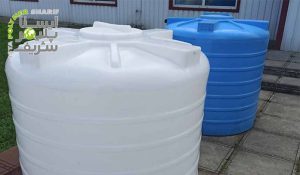One of the most commonly used tanks is the polyethylene tank. This type of tank is widely used in various industries such as agriculture, animal husbandry, horticulture, construction, and more due to its numerous features and advantages. These tanks are used to store various liquids, including water, in both warm and cold seasons. Therefore, it is crucial to consider methods to prevent the freezing of polyethylene tanks. In this article, we introduce some methods to prevent the freezing of water in polyethylene tanks.
What is Meant by Freezing of the Tank?
In cold seasons, the air temperature in some cold regions of the country drops below zero degrees, causing various water tanks to freeze. When the cold weather persists for a long time and the tanks have not been used for an extended period, the stagnant water inside them freezes. Although polyethylene tanks are highly resistant to cold, they will freeze under such conditions.
Methods to Prevent Freezing of Polyethylene Tanks
Polyethylene tanks, as the name suggests, are made of polyethylene. When exposed to extreme cold, these tanks can become brittle and crack. Therefore, it is necessary to find ways to prevent the freezing of polyethylene tanks. Below are some of the most effective and common methods to prevent tank freezing.
Storing Solar Heat
One of the most important and simplest effective ways to prevent the freezing of polyethylene tanks is to store solar radiation energy. By trapping sunlight inside the tank, freezing is prevented. This method is one of the most cost-effective and basic ways to prevent tank freezing.
Using Tanks with a Capacity Greater than the Volume of Water Inside
Another effective method to prevent the freezing of polyethylene tanks is to use a tank with a capacity larger than the volume of water inside. Larger capacity tanks require more time to freeze compared to smaller capacity tanks. When the tank is refilled, the fresh water has a higher temperature than the water inside the tank, requiring more time to freeze.
Insulating Water Tanks
One of the fundamental and logical methods to prevent the freezing of polyethylene tanks is to insulate the tanks. By covering the outer body of the tank, the internal heat loss is prevented. This method requires careful insulation of the entire tank body. If any part of the body remains uninsulated, the tank may still freeze. It is noteworthy that the insulation wears out over time and needs replacement. Various types of insulation can be used for this purpose, including fiberglass, styrofoam, and more.
Using a Water Heating System
Using a heating system inside the tank ensures that the water temperature remains above the freezing point, preventing the tank from freezing. A simple small electric water heater that is placed in the water can be used for this purpose. If more complex heating systems are used, they can also be attached to the tank walls. This way, the entire tank space is heated, and the temperature inside the tank stays above zero.
Keeping Water Flowing
One effective and efficient method to prevent the freezing of a polyethylene tank is to keep the water flowing inside it. When water flows, its temperature increases, preventing it from freezing. During the cold seasons, it is advisable to occasionally open the tank’s outlet and drain valves to allow the water to flow. It is important to note that the water drainage should be sufficient to raise the tank’s internal temperature.
Choosing a Tank with an Appropriate Shape
The shape of the tank significantly affects the likelihood of freezing. Tanks with flat tops are more prone to freezing because during severe cold and precipitation, water remains on the top surface and freezes. This reduces the water inside the tank and eventually causes the entire tank to freeze. Therefore, when purchasing, it is better to choose a tank with a rounder and more sloped top. Among various polyethylene tanks, horizontal and vertical tanks are better options to prevent freezing.
Regularly Checking Pipes and Other Connections
Pipes and connections are parts of the tank, and if they leak or have holes, they can cause freezing in the tank. Therefore, the tank’s connections should always be checked and monitored. If any leaks are found, the specific pipe should be repaired or replaced if possible.
Burying the Tank
Burying tanks underground is another effective way to prevent the freezing of polyethylene tanks. For this purpose, tanks designed to be buried should be used. These are known as burial tanks, and buyers should inquire about this feature from the seller at the time of purchase. In emergencies, if there is a need to bury a regular tank, it should first be placed in protective enclosures or walls and then buried.
Conclusion
One of the recurring issues with using polyethylene tanks during the cold seasons is preventing the tank from freezing. Therefore, in this article, we introduced some of the most effective methods to prevent polyethylene tanks from freezing. These methods include insulating the water tank, using tanks with a larger capacity than the water inside, checking the tank’s connections and pipes, using tanks with rounded and sloped surfaces, keeping the water flowing inside the tank, and using heating systems inside the tank.






